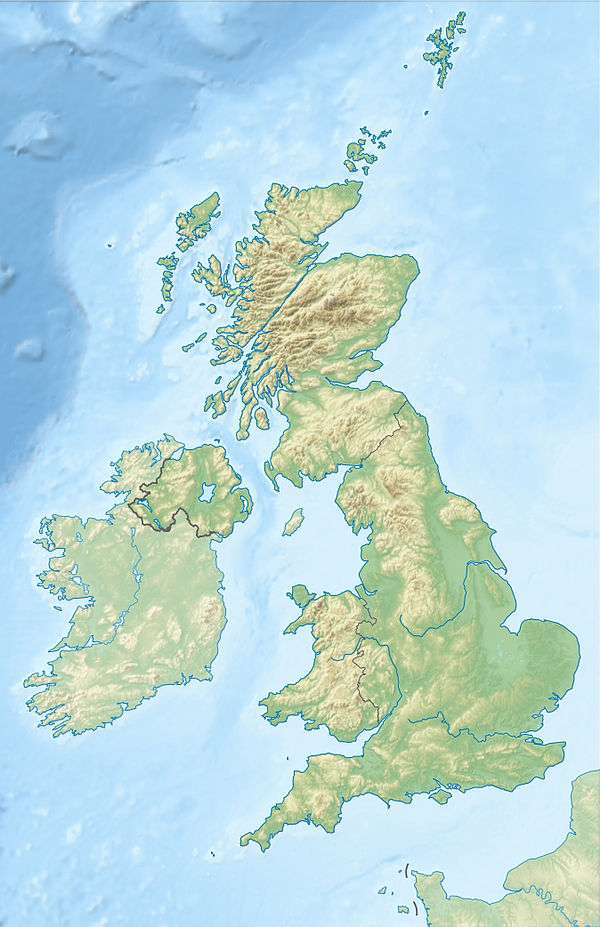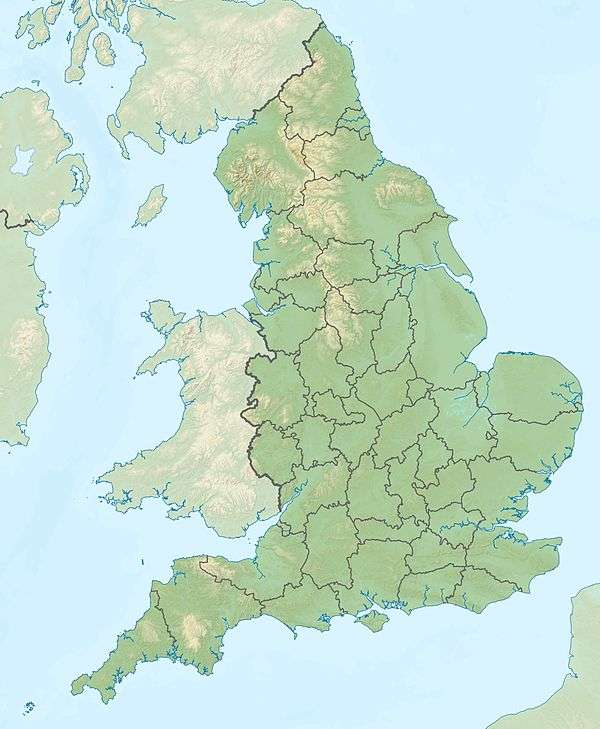Whitby Mudstone
The Whitby Mudstone is a Toarcian (Early Jurassic; Falciferum-Bifrons in regional chronostratigraphy) geological formation in Yorkshire and Worcestershire, England.[1] The formation, part of the Lias Group, is present in the Cleveland and Worcester Basins and the East Midlands Shelf.
| Whitby Mudstone Stratigraphic range: Toarcian (Falciferum-Bifrons) ~183–176 Ma | |
|---|---|
| Type | Geological formation |
| Unit of | Lias Group |
| Sub-units | Members:
|
| Underlies | Inferior Oolite or Ravenscar Groups Or Blea Wyke, Dogger or Bridport Sand Formations |
| Overlies | Marlstone Rock or Cleveland Ironstone Formations |
| Thickness | Up to 120 m (390 ft) |
| Lithology | |
| Primary | Mudstone |
| Other | Siltstone |
| Location | |
| Coordinates | 54.5°N 0.6°W |
| Approximate paleocoordinates | 42.5°N 9.3°E |
| Region | Yorkshire, Worcestershire |
| Country | |
| Extent | Cleveland & Worcester Basins & East Midlands Shelf |
| Type section | |
| Named for | Whitby |
 Whitby Mudstone (the United Kingdom)  Whitby Mudstone (England) | |
Fossil content
Dinosaur remains are among the fossils that have been recovered from the formation, although none have yet been referred to a specific genus.[2][3]. One of the more notable discoveries is the skull of the pterosaur Parapsicephalus, found within the Alum Shale[note 2] Member.[4]
See also
- List of fossiliferous stratigraphic units in England
- Toarcian turnover
- Toarcian formations
- Marne di Monte Serrone, Italy
- Calcare di Sogno, Italy
- Sachrang Formation, Austria
- Posidonia Shale, Lagerstätte in Germany
- Ciechocinek Formation, Germany and Poland
- Krempachy Marl Formation, Poland and Slovakia
- Lava Formation, Lithuania
- Azilal Group, North Africa
- Junction Bed, Toarcian fossiliferous unit of the Lias Group
- Fernie Formation, Alberta and British Columbia
- Poker Chip Shale
- Whiteaves Formation, British Columbia
- Navajo Sandstone, Utah
- Los Molles Formation, Argentina
- Mawson Formation, Antarctica
- Kandreho Formation, Madagascar
- Kota Formation, India
- Cattamarra Coal Measures, Australia
Notes and references
Notes
- Not to be confused with the Ordovician Alum Shale Lagerstätte of Sweden
- Not to be confused with the Ordovician Alum Shale Lagerstätte of Sweden
References
- Whitby Mudstone at Fossilworks.org
- "Whitby Mudstone Formation". The BGS lexicon of named rock units. British Geological Survey. Retrieved 1 November 2016.
- Weishampel et al., 2004, pp. 517-607
- O'Sullivan & Martill, 2017
Bibliography
- O'Sullivan, Michael, and David M. Martill. 2017. The taxonomy and systematics of Parapsicephalus purdoni (Reptilia: Pterosauria) from the Lower Jurassic Whitby Mudstone Formation, Whitby, U.K. Historical Biology 29. 1009–1018. Accessed 2020-03-12. doi:10.1080/08912963.2017.1281919
- Weishampel, David B.; Peter Dodson, and Halszka Osmólska (eds.). 2004. The Dinosauria, 2nd edition, 1–880. Berkeley: University of California Press. Accessed 2019-02-21.ISBN 0-520-24209-2
Further reading
- M. O'Sullivan, D. M. Martill, and D. Groocock. 2013. A pterosaur humerus and scapulocoracoid from the Jurassic Whitby Mudstone Formation, and the evolution of large body size in early pterosaurs. Proceedings of the Geologists' Association
- A. S. Smith and G. J. Dyke. 2008. The skull of the giant predatory pliosaur Rhomaleosaurus cramptoni: implications for plesiosaur phylogenetics. Naturwissenschaften 95:975-980
- M. J. Benton and M. A. Taylor. 1984. Marine reptiles from the Upper Lias (Lower Toarcian, Lower Jurassic) of the Yorkshire coast. Proceedings of the Yorkshire Geological Society 44(4):399-429
- F. v. Huene. 1926. The carnivorous Saurischia in the Jura and Cretaceous formations, principally in Europe. Revista del Museo de La Plata 29:35-167
- C. W. Andrews. 1922. Note on the skeleton of a large plesiosaur (Rhomaleosaurus thorntoni, sp. n) from the Upper Lias of Northamptonshire. Annals and Magazine of Natural History 10:407-415
- R. Tate and J. F. Blake. 1876. The Yorkshire Lias 1-475
This article is issued from Wikipedia. The text is licensed under Creative Commons - Attribution - Sharealike. Additional terms may apply for the media files.